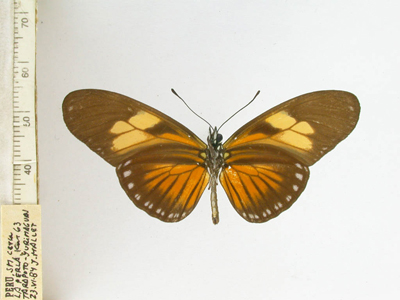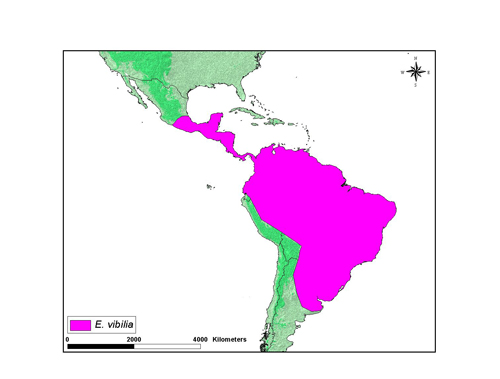Eueides vibilia
Margarita BeltránCharacteristics
Early stages: Eggs are red and white and approximately 1 x 0.8 mm (h x w). Females usually place 30 to 60 eggs under older leaves of the host plant. Mature larvae have a yellow body with black spots, with black scoli and head; length is around 2 cm. Caterpillars are gregarious. All stages of E. vibilia larvae appear to mimic the larvae of the gregarious Heliconius hewitsoni, and can be distinguished from them principally by having the head spines shorter and their habit of skeletonizing older leaves, rather than eating young shots (Brown, 1991; Mallet and Longino, 1982). Pupae are creamy-white with black spots and with the four dorsal spines roughly the same length (DeVries, 1997; Mallet and Longino, 1982).
Geographical distribution
Eueides vibilia is distributed from Mexico to Brazil. The map below shows an approximate representation of the geographic distribution of this species. The original data used to draw these maps are derived from Brown (1979) which is available at Keith S. Brown Jr. (1979). Ecological Geography and Evolution in Neotropical Forests.
Habits
E. vibilia occurs from sea level to 800 m in open forests. Usually individuals fly rapidly in the canopy. The males sit on female pupae a day before emergence, and mating occurs the next morning, before the female has completely eclosed. Adults roost in loose groups at night (Brown, 1981, DeVries, 1997).
Hostplant: E. vibilia larvae feed primarily on plants from the genus Dilkea, Mitostemma and Passiflora (Brown, 1981). In Costa Rica E. v. vialis feed on Passiflora pittieri (DeVries, 1997; Mallet and Longino, 1982).
References
Brown K. S. 1979. Ecologia Geográfica e Evolução nas Florestas Neotropicais. 2 vols. (Tese apresentada à Universidade Estadual de Campinas como parte das exigências de um Concurso de Livre Docência, area de Ecologia). Universidade Estadual de Campinas, Campinas, Brazil.
Brown K. S. 1981 The Biology of Heliconius and Related Genera. Annual Review of Entomology 26, 427-456.
DeVries P. J. 1997 The Butterflies of Costa Rica and Their Natural History, Volume I: Papilionidae, Pieridae, Nymphalidae Princeton University Press, Baskerville, USA.
Godart J. B. 1819 Pp. 13-328. In: Latreille, P. A. & J. B. Godart, Encyclopédie Méthodique. Histoire naturelle. Entomologie, ou histoire naturelle des crustacés, des arachnides et des insectes. Paris, veuve Agasse. 9(1): i-ii, 3-328 (before [13 February])
Mallet J. Longino JT. 1982 Hostplant records and descriptions of juvenile stages for two rare species of Eueides(Nymphalidae). Journal of the Lepidopterists' Society 36, 136-144.
Schmadel L. 2003 Dictionary of Minor Planet Names, %th edition. Published by Springer. 992 pp.
Title Illustrations

| Scientific Name | Eueides vibilia unifasciata |
|---|---|
| Specimen Condition | Dead Specimen |
| View | dorsal |
| Collection | Gerardo Lamas |
| Image Use |
 This media file is licensed under the Creative Commons Attribution-NonCommercial-ShareAlike License - Version 3.0. This media file is licensed under the Creative Commons Attribution-NonCommercial-ShareAlike License - Version 3.0.
|
| Copyright |
©

|
| Scientific Name | Eueides vibilia unifasciata |
|---|---|
| Specimen Condition | Dead Specimen |
| View | ventral |
| Collection | Gerardo Lamas |
| Image Use |
 This media file is licensed under the Creative Commons Attribution-NonCommercial-ShareAlike License - Version 3.0. This media file is licensed under the Creative Commons Attribution-NonCommercial-ShareAlike License - Version 3.0.
|
| Copyright |
©

|
About This Page

University of Cambridge, Cambridge, UK
Correspondence regarding this page should be directed to Margarita Beltrán at
Page copyright © 2009
 Page: Tree of Life
Eueides vibilia .
Authored by
Margarita Beltrán.
The TEXT of this page is licensed under the
Creative Commons Attribution-NonCommercial-ShareAlike License - Version 3.0. Note that images and other media
featured on this page are each governed by their own license, and they may or may not be available
for reuse. Click on an image or a media link to access the media data window, which provides the
relevant licensing information. For the general terms and conditions of ToL material reuse and
redistribution, please see the Tree of Life Copyright
Policies.
Page: Tree of Life
Eueides vibilia .
Authored by
Margarita Beltrán.
The TEXT of this page is licensed under the
Creative Commons Attribution-NonCommercial-ShareAlike License - Version 3.0. Note that images and other media
featured on this page are each governed by their own license, and they may or may not be available
for reuse. Click on an image or a media link to access the media data window, which provides the
relevant licensing information. For the general terms and conditions of ToL material reuse and
redistribution, please see the Tree of Life Copyright
Policies.
- First online 18 February 2007
- Content changed 04 September 2008
Citing this page:
Beltrán, Margarita. 2008. Eueides vibilia . Version 04 September 2008 (under construction). http://tolweb.org/Eueides_vibilia/72956/2008.09.04 in The Tree of Life Web Project, http://tolweb.org/











 Go to quick links
Go to quick search
Go to navigation for this section of the ToL site
Go to detailed links for the ToL site
Go to quick links
Go to quick search
Go to navigation for this section of the ToL site
Go to detailed links for the ToL site